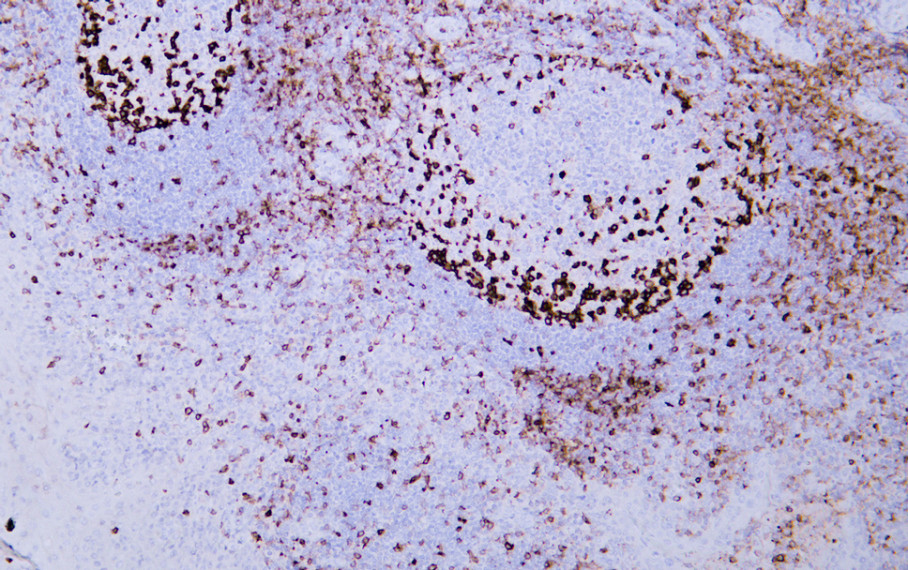PD-1 (ABT-PD1) mouse mAb (Ready to Use)
- Catalog No.:YM6208R
- Applications:IHC
- Reactivity:Human;
- Target:
- PD1
- Fields:
- >>Cell adhesion molecules;>>T cell receptor signaling pathway;>>PD-L1 expression and PD-1 checkpoint pathway in cancer
- Gene Name:
- PDCD1 PD1
- Protein Name:
- Programmed cell death protein 1 (Protein PD-1) (hPD-1) (CD antigen CD279)
- Human Gene Id:
- 5133
- Human Swiss Prot No:
- Q15116
- Immunogen:
- Synthesized peptide derived from human PD-1 AA range: 1-100
- Specificity:
- This antibody detects endogenous levels of human PD-1. Heat-induced epitope retrieval (HIER) Citrate buffer of pH6.0 was highly recommended as antigen repair method in paraffin section
- Formulation:
- Liquid in PBS containing 50% glycerol, 0.5% BSA and 0.02% sodium azide.
- Source:
- Mouse, Monoclonal/IgG1, Kappa
- Dilution:
- Ready to use for IHC
- Purification:
- The antibody was affinity-purified from mouse ascites by affinity-chromatography using specific immunogen.
- Storage Stability:
- 2°C to 8°C/1 year
- Background:
- This gene encodes a cell surface membrane protein of the immunoglobulin superfamily. This protein is expressed in pro-B-cells and is thought to play a role in their differentiation. In mice, expression of this gene is induced in the thymus when anti-CD3 antibodies are injected and large numbers of thymocytes undergo apoptosis. Mice deficient for this gene bred on a BALB/c background developed dilated cardiomyopathy and died from congestive heart failure. These studies suggest that this gene product may also be important in T cell function and contribute to the prevention of autoimmune diseases. [provided by RefSeq, Jul 2008],
- Function:
- developmental stage:Induced at programmed cell death.,disease:Genetic variation in PDCD1 is associated with susceptibility to systemic lupus erythematosus type 2 (SLEB2) [MIM:605218]. Systemic lupus erythematosus is a chronic, inflammatory and often febrile multisystemic disorder of connective tissue. It affects principally the skin, joints, kidneys and serosal membranes. It is thought to represent a failure of the regulatory mechanisms of the autoimmune system.,function:Possible cell death inducer, in association with other factors.,similarity:Contains 1 Ig-like V-type (immunoglobulin-like) domain.,subunit:Monomer.,
- Subcellular Location:
- Membranous, Cytoplasmic
- Expression:
- Placenta,Pooled tissue,Uterine cervix,
- June 19-2018
- WESTERN IMMUNOBLOTTING PROTOCOL
- June 19-2018
- IMMUNOHISTOCHEMISTRY-PARAFFIN PROTOCOL
- June 19-2018
- IMMUNOFLUORESCENCE PROTOCOL
- September 08-2020
- FLOW-CYTOMEYRT-PROTOCOL
- May 20-2022
- Cell-Based ELISA│解您多样本WB检测之困扰
- July 13-2018
- CELL-BASED-ELISA-PROTOCOL-FOR-ACETYL-PROTEIN
- July 13-2018
- CELL-BASED-ELISA-PROTOCOL-FOR-PHOSPHO-PROTEIN
- July 13-2018
- Antibody-FAQs
- Products Images
.jpg)
- Human lymphoma tissue was stained with Anti-PD-1 (ABT-PD1) Antibody
.jpg)
- Human lymphoma tissue was stained with Anti-PD-1 (ABT-PD1) Antibody
.jpg)
- Human lymphoma tissue was stained with Anti-PD-1 (ABT-PD1) Antibody

- Human tonsil tissue was stained with Anti-PD-1 (ABT-PD1) Antibody

- Fluorescence multiplex immunohistochemical analysis of normal human appendix tissue (formalin-fixed paraffin-embedded section).The section was incubated in 3 rounds of staining; in the order of CK PAN .( Catalog no:YM6815 1/200 dilution), PD-1.(Catalog no: YM6208 1/200 dilution), Caldesmon pan. (Catalog no:YM6826 1/200 dilution),each using a separate fluorescent tyramide signal amplification system : Treble-Fluorescence immunohistochemical mouse/rabbit kit Catalog NO: RS0035 (pH9.0)
.png)
- Zou, Ming‐Xiang, et al. "A four‐factor immune risk score signature predicts the clinical outcome of patients with spinal chordoma." Clinical and translational medicine 10.1 (2020): 224-237.


